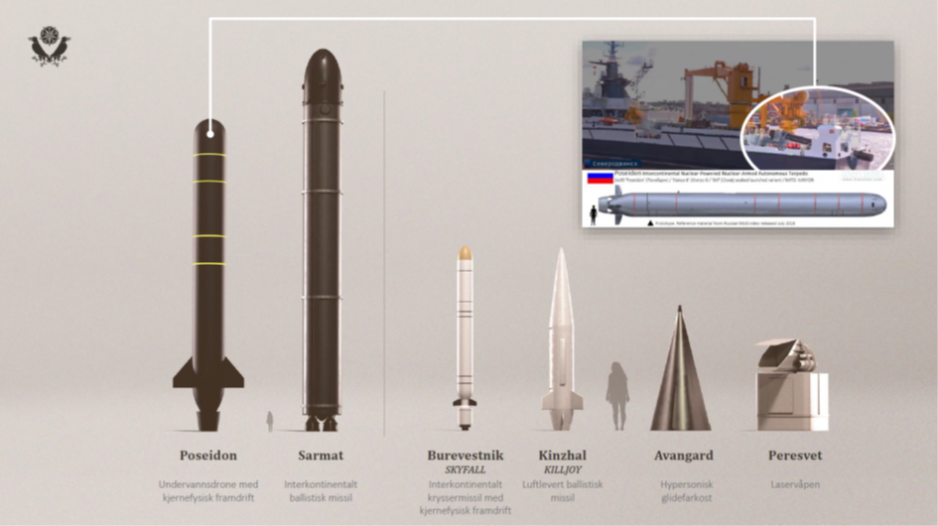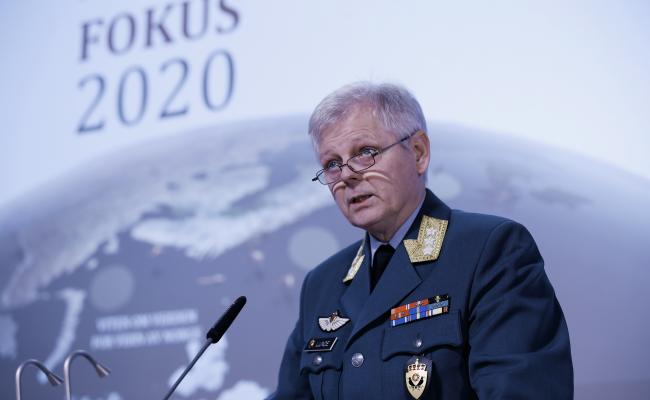From Norway to North America: Differing Views On New Russian Weapon Systems

Photo: Illustration from presentation held at "Oslo Military Society" Monday February 10, by the Head of the Norwegian Foreign Intelligence Services.
For Norway, new Russian weapon systems do not constitute a dramatic change in the potential threat from Russia, says researcher. For the Arctic more broadly, disagreement exists on what these weapons mean for the security situation in the region.
Earlier this month, the Norwegian Foreign Intelligence Service presented its annual report Focus; a non-classified assessment of current security challenges for Norway. In the report, threats stemming from both Russia and China are at the center of attention.
The report highlights Russia’s development of new weapon systems, referring to the six new weapon systems that President Vladimir Putin presented in his yearly speech to the nation in 2018.
- There is little doubt that Russia is a leader within missile technology. There are several different areas where Russia lies behind the standard in Nato, but missile technology is not one of them, Paal Sigurd Hilde, Associate Professor at the Norwegian Institute for Defence Studies (IFS), points out to High North News.
- What does Russia aim to achieve with the development of new weapon systems?
- The goal is likely twofold. One of the aims is to increase the country’s military ability. The other is more political, in that developing and displaying such advanced weapon systems contribute to give Russia the sought-after great power status, additionally, and also therefore, it resonates well with the Russian population.
Some of the new weapon systems that Russia has developed in recent years, such as the new ground-launched cruise missile 9M729, Nato-name: SSC-8 Screwdriver, as well as the airborne, hypersonic missile “Kinzhal”, are relevant to Norwegian security as they both have a range that could make Norway a target, Hilde says.
The SSC-8 Screwdriver is a ground-launched cruise missile which, according to the U.S. and Nato allies, violates the range and launcher regulations of the Intermediate-Range Nuclear Forces (INF) Treaty.
The Kinzhal hypersonic missile is an air-launched ballistic missile with a range of 1,500 - 2,000 kilometers [medium range]. In 2019, Russia tested one such missile in the Arctic.
New runways at both Franz Josef Land and Novaya Zemlya are announced to facilitate MiG-31K fighter jets which, armed with the Kinzhal missile, in practice could pose a threat it is not possible to defend against in the European Arctic, northern Scandinavia and North Atlantic, the Barents Observer writes.
It is important to remember that Russia for a long time has had the ability to attack targets in all of Norway.
Hilde says that the new Russian weapon systems is an increase in the potential threat from Russia, but not a dramatic change to Norwegian security.
- It is important to remember that Russia for a long time has had the ability to attack targets in all of Norway, particularly with missiles from naval vessels and bombers.
Also read
Hypersonic threat
Several of the weapons that Russia and Putin have developed in recent years are strategic, in the sense that they are mainly aimed at the U.S., and Nato more generally, as well as China and other potential challengers, Hilde points out.
He adds that it is particularly the systems connected to intercontinental missiles that are mainly focused towards the U.S.
Rob Huebert, political science professor at the University of Calgary in Canada, contends that there is no real difference between regional and strategic.
- For the Russians it will be the same, and that means any effort on our part to differentiate will be dangerous for us.
The Avangard, one of the new weapon systems presented, is an intercontinental ballistic missile system with a gliding hypersonic maneuvering warhead (Hypersonic Glide Vehicle). It is capable of carrying a nuclear warhead and has a range over 6,000 km. The maneuverability of the glide vehicle could make Avangard’s trajectory unpredictable, complicating intercept attempts after its boost phase.
In a hearing in the U.S. Senate in 2018, U.S. General John Hyten, Commander of the U.S. Strategic Command at the time, explained that “a hypersonic threat is a system that starts out ballistic, and so you will see it like a ballistic missile, but then it depresses the trajectory and then flies more like a cruise missile or an airplane. So it goes up into the low reaches of space and then turns immediately back down and then levels out and flies at a very high level of speed.”
General Hyten added that “both Russia and China are developing hypersonic capabilities. We have watched them test those capabilities. So both Russia and China are aggressively pursuing hypersonic capabilities.”
Out of balance?
In North America, concerns are raised about the threat stemming from such weapon technology.
- There really isn’t any defense systems that we have in the West at this point, says Huebert.
In the hearing, General Hyten also noted that “we do not have any defense that could deny the employment of such a weapon against us. So our response would be our deterrent force, which would be the triad and the nuclear capabilities that we have to respond to such a threat.”
- What the Russians brag most about is their hypersonic capability. These missiles are capable of going hypersonic [at least five times the speed of sound], and due to their longer range they can be fired from different locations, from fighter jets that for instance can fire from somewhere over the Arctic, Huebert points out.
- Because of the lack of modernization that the U.S. and Canada have in terms of their surveillance systems, there is a real good expectation that we’ll be totally taken by surprise. This is the major focus that we see in larger militaries in the West in 2019-2020.
- Are these threats at the top of the political agenda in the U.S. and in Canada?
- In the U.S., yes. Our [Canadian] government has said modernization of Norad is at the top of importance, but they have attached no money for it. We do not see any associated funds with the Norad modernization and worse, we do not see any movement in terms of any consideration to join the American anti-ballistic weapon systems.
We have had a general belief that Arctic exceptionalism somehow means that geopolitical realities just disappeared.
Huebert expresses concerns about the naivety that he says Canada has had to events occurring in the Arctic.
- We have had a general belief that Arctic exceptionalism somehow means that geopolitical realities just disappeared.
- If you look at the Russian expenditure from 2007 to 2015 when in fact they started rebuilding and modernizing all of their military, you can see that the focus was on the Arctic, and particularly on rebuilding their nuclear deterrent. Starting in 2008, what that meant was whole-scale efforts to reinvigorate the submarine force and bomber nuclear deterrent. In North America we pretended that was just business as usual, but it should have been apparent that it was the beginning of a new era.
At the same time as they were rebuilding existing forces, the Russians also started investing in new weapon technology. This is in part to return to great power status; to push back Western/NATO gains; and to counter American advances in anti-ballistic missile (ABM) capabilities, Huebert adds.
Also read
- USA, Russia and China, “the three-legged strategic stool”
The new weapon systems can be seen as part of a broader development in the global strategic environment where the U.S., Russia and China compete.
- China has ambitions to be a great power. In 2016 it had the second largest defence budget. The Chinese are spending more and developing more war ships. There is an expectation that they will catch up with the Americans in 10-15 years, Huebert says.
According to Huebert, the U.S. is concerned about what the development of Chinese hypersonic weapons will mean for the security of their naval forces and adds that hypersonic in the Chinese context, really is an effort to be able to defeat the American carrier battle group.
- The other issue is that the Chinese have enough money to build these hypersonic weapons and building enough of them to basically be able to overwhelm any defensive system that you might have towards them.
Within the Arctic moreover, the USA, Russia and China, are a three-legged strategic stool, which means the region will become even more important as a geopolitical location, according to Huebert.
- We now have an international geopolitical environment in which the Arctic is central for the Russians, he says, and adds that the introduction of the hypersonic weapon systems that we cannot detect, may mean we are entering into a very dangerous international system.
A game changer for the Arctic?
Paal Sigurd Hilde notes that the development of new weapon systems will most likely not change the security situation in the High North in the short term perspective. This is about missiles that can go further and faster – about increased military ability.
- There is nothing so far that points to that these new weapon systems mean something for Russia’s basic interests in the Arctic and the High North, which essentially is all about protecting its strategic submarines as well as economic interests and sovereignty.
- Will this development lead the U.S. to increase its presence in the European High North?
- That is too early to say, but it does not seem likely that these weapon systems alone will have such an effect.
- What could provoke the deployment of American systems in the European Arctic is that Russian weapon systems that make up a particular, potential threat to the United States, are deployed there.
- We will, however, not see many of the new strategic weapon systems in the Arctic region, Hilde notes.
Huebert on the other hand argues that the launch vehicles for these will increasingly be launched from bombers based at the reactivated airbases in the north and from the Northern Fleet based in the Murmansk region.
- The Arctic will be the central region because any effort on the US part to meet the threat means attacking the bases before the missiles are fired. The Russians know this and are or will move to strengthen their local defences, he says.
Hilde adds that it nevertheless important to remember that several of the new “super weapons” are still under development.
- And it is still uncertain whether they will actually become operational. And even if they are, it is uncertain if Russia can afford many of them. Russian economy is not in good shape and that also affects the defence budgets. So yes, there may be some “hype” with regards to these weapon systems.







